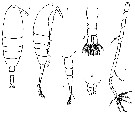|
|
 |
Fiche d'espèce de Copépode |
|
|
Calanoida ( Ordre ) |
|
|
|
Diaptomoidea ( Superfamille ) |
|
|
|
Acartiidae ( Famille ) |
|
|
|
Acartia ( Genre ) |
|
|
| |
Acartia mollicula Pavlova & Shmeleva, 2010 (F, stage 5 M) | |
| | | | | | | Ref.: | | | Pavlova & Shmeleva, 2010 (p. e-2, figs.F, stage 5 M) |  issued from : E.V. Pavlova & A.A. Shmeleva in Vestnik zoologii, 2010, 44 (2). [p. e-2, Fig.1]. Female (from martyn Bay: Black Sea): 1, 3, habitus (dorsal and lateral, respectively); 2, urosome (dorsal); 4, last thoracic segment and urosome (lateral); 5, rostrum (dorsal view); 6, A1; 7, A2; 8, Md. Nota: Rostrum small, without rostral filaments. : Prosome to urosome ratio 76.0 : 24.0. A1 19-segmented, almost reaching posterior margin of genital somite ; segment 4 with 1 spine. A2 with distinctly separated coxa and basis bearing 1 seta ; basis and 1st endopodal segment fused (forming elongated allobasis) bearing 6 proximal setae and 1 distal seta along inner margin ; 2nd endopodal segment elongated, with 7 setae ; 3rd endopodal segment short, with 7 setae . Exopod short, 4-segmented ; setation formula 1, 2, 2, 3. Md : coxa with well developed gnathobase. Basis bearing 1 seta covered with spinules ; endopod 2-segmented, with 2 and 9 setae on the 1st and 2nd segments, respectively. Exopod 5-segmented, with setation formula 1, 1, 1, 1, 2 setae. Urosome 3-segmented, without any tooth and spines onthe distal margin. Genital segment nearly as long as wide, symmetrical in dorsal view and ventral surface, without processes, with lateral swellings at both sides. Caudal rami 2.5 times as long as wide.
|
 issued from : E.V. Pavlova & A.A. Shmeleva in Vestnik zoologii, 2010, 44 (2). [p. e-3, Fig.2]. Female: 1, Mx1; 2, Mx2; 3, Mxp; 4-7, P1 to P4, respectively; 8, P5. Nota : Mx1 : praecoxa and coxa incompletely fused ; praecoxal segment with 9 setae ; coxa with endite bearing 3 setae ; epipodite with 9 setae ; basis with 1 inner seta and 1 outer seta ; endopod absent ; exopod bearing 7 setae furnished with hairs along inner margin. Mx2 : praecoxa and coxa with 2 endites and 14 setae ; with formula 5, 2, 3, 2, 2. Mxp comprising robust syncoxa and basis of 2 segments of 2-segmented endopod ; syncoxa with setation formula 0, 2, 2, 1 ; basis bearing 1 short seta ; the 1st and 2nd endopodal segments having 3 and 2 short setae. P5 3-segmented (including one distal segment of basipod) and symmetrical, without large spine. Proximal and distal segments without setae on posterior surface. Distal segment slightly longer than preceeding. Single lateral seta very long, 10 times longer than spine.
|
 issued from : E.V. Pavlova & A.A. Shmeleva in Vestnik zoologii, 2010, 44 (2). [p. e-4, Table 1]. Female: Setae formula of the armature of swimming legs P1 to P4. Number of setae from outer to inner segment.
|
 issued from : E.V. Pavlova & A.A. Shmeleva in Vestnik zoologii, 2010, 44 (2). [p. e-5, Table 2]. Female: Dimensions and characters of female..
|
 issued from : E.V. Pavlova & A.A. Shmeleva in Vestnik zoologii, 2010, 44 (2). [p. e-4, Fig.3]. Male stage V: 1, 3, habitus (dorsal and lateral, respectively); 2, urosome (dorsal); 4, urosome (lateral, left side); 5, right A1; 6, P5. Nota : Rostrum very small. Right A1 not geniculate. 4th urosomal somite longer than 3rd. Distal segment of with single small spine.P5 Caudal rami symmetrical, about 3 times as long as wide, with straight inner margins ; caudal setae as in females.
| | | | | Ref. compl.: | | | Shmeleva & al., 2008 (p.31, Table 1); Gubanova & al., 2013 (in press, Rem.: p.6, Table 3) | | | | NZ: | 2 | | |
|
Carte de distribution de Acartia mollicula par zones géographiques
|
| | | | | | | Loc: | | | Black Sea (Martyn Bay, Black River estuary), Marmara Sea, Levantine Sea, Red Sea. | | | | N: | 3 | | | | Lg.: | | | (1045) F: 0,575-0,700; M stage V: 0,600; {F: 0,575-0,700} | | | | Rem.: | côtière
Voir aussi les remarques en anglais | | | Dernière mise à jour : 02/02/2015 | |
|
|
 Toute utilisation de ce site pour une publication sera mentionnée avec la référence suivante : Toute utilisation de ce site pour une publication sera mentionnée avec la référence suivante :
Razouls C., Desreumaux N., Kouwenberg J. et de Bovée F., 2005-2025. - Biodiversité des Copépodes planctoniques marins (morphologie, répartition géographique et données biologiques). Sorbonne Université, CNRS. Disponible sur http://copepodes.obs-banyuls.fr [Accédé le 24 octobre 2025] © copyright 2005-2025 Sorbonne Université, CNRS
|
|
 |
 |







